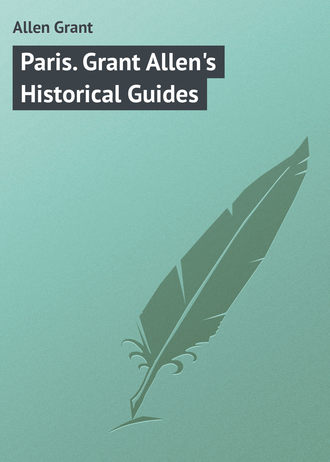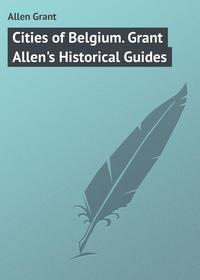 полная версия
полная версияParis. Grant Allen's Historical Guides

Grant Allen
Paris / Grant Allen's Historical Guides
INTRODUCTION
THE object and plan of these Historical Handbooks is somewhat different from that of any other guides at present before the public. They do not compete or clash with such existing works; they are rather intended to supplement than to supplant them. My purpose is not to direct the stranger through the streets and squares of an unknown town towards the buildings or sights which he may desire to visit; still less is it my design to give him practical information about hotels, cab fares, omnibuses, tramways, and other every-day material conveniences. For such details, the traveller must still have recourse to the trusty pages of his Baedeker, his Joanne, or his Murray. I desire rather to supply the tourist who wishes to use his travel as a means of culture with such historical and antiquarian information as will enable him to understand, and therefore to enjoy, the architecture, sculpture, painting, and minor arts of the towns he visits. In one word, it is my object to give the reader in a very compendious form the result of all those inquiries which have naturally suggested themselves to my own mind during thirty-five years of foreign travel, the solution of which has cost myself a good deal of research, thought, and labour, beyond the facts which I could find in the ordinary handbooks.
For several years past I have devoted myself to collecting and arranging material for a set of books to embody the idea I had thus entertained. I earnestly hope they may meet a want on the part of tourists, especially Americans, who, so far as my experience goes, usually come to Europe with an honest and reverent desire to learn from the Old World whatever of value it has to teach them, and who are prepared to take an amount of pains in turning their trip to good account which is both rare and praiseworthy. For such readers I shall call attention at times to other sources of information.
These guide-books will deal more particularly with the Great Towns where objects of art and antiquity are numerous. In every one of them, the general plan pursued will be somewhat as follows. First will come the inquiry why a town ever gathered together at all at that particular spot – what induced the aggregation of human beings rather there than elsewhere. Next, we shall consider why that town grew to social or political importance and what were the stages by which it assumed its present shape. Thirdly, we shall ask why it gave rise to that higher form of handicraft which we know as Art, and towards what particular arts it especially gravitated. After that, we shall take in detail the various strata of its growth or development, examining the buildings and works of art which they contain in historical order, and, as far as possible, tracing the causes which led to their evolution. In particular, we shall lay stress upon the origin and meaning of each structure as an organic whole, and upon the allusions or symbols which its fabric embodies.
A single instance will show the method upon which I intend to proceed better than any amount of general description. A church, as a rule, is built over the body or relics of a particular saint, in whose special honour it was originally erected. That saint was usually one of great local importance at the moment of its erection, or was peculiarly implored against plague, foreign enemies, or some other pressing and dreaded misfortune. In dealing with such a church, then, I endeavour to show what were the circumstances which led to its erection, and what memorials of these circumstances it still retains. In other cases it may derive its origin from some special monastic body – Benedictine, Dominican, Franciscan – and may therefore be full of the peculiar symbolism and historical allusion of the order who founded it. Wherever I have to deal with such a church, I try as far as possible to exhibit the effect which its origin had upon its architecture and decoration; to trace the image of the patron saint in sculpture or stained glass throughout the fabric; and to set forth the connection of the whole design with time and place, with order and purpose. In short, instead of looking upon monuments of the sort mainly as the product of this or that architect, I look upon them rather as material embodiments of the spirit of the age – crystallizations, as it were, in stone and bronze, in form and colour, of great popular enthusiasms.
By thus concentrating attention on what is essential and important in a town, I hope to give in a comparatively short space, though with inevitable conciseness, a fuller account than is usually given of the chief architectural and monumental works of the principal art-cities. In dealing with Paris, for example, I shall have little to say about such modern constructions as the Champs Elysées or the Eiffel Tower; still less, of course, about the Morgue, the Catacombs, the waxworks of the Musée Grévin, and the celebrated Excursion in the Paris Sewers. The space thus saved from vulgar wonders I shall hope to devote to fuller explanation of Notre-Dame and the Sainte Chapelle, of the mediæval carvings or tapestries of Cluny, and of the pictures or sculptures in the galleries of the Louvre. Similarly in Florence, whatever I save from description of the Cascine and even of the beautiful Viale dei Colli (where explanation is needless and word-painting superfluous), I shall give up to the Bargello, the Uffizi, and the Pitti Palace. The passing life of the moment does not enter into my plan; I regard each town I endeavour to illustrate mainly as a museum of its own history.
For this reason, too, I shall devote most attention in every case to what is locally illustrative, and less to what is merely adventitious and foreign. In Paris, for instance, I shall have more to say about truly Parisian art and history, as embodied in St. Denis, the Île de la Cité, and the shrine of Ste. Geneviève, than about the Egyptian and Assyrian collections of the Louvre. In Florence, again, I shall deal rather with the Etruscan remains, with Giotto and Fra Angelico, with the Duomo and the Campanile, than with the admirable Memlincks and Rubenses of the Uffizi and the Pitti, or with the beautiful Van der Goes of the Hospital of Santa Maria. In Bruges and Brussels, once more, I shall be especially Flemish; in the Rhine towns, Rhenish; in Venice, Venetian. I shall assign a due amount of space, indeed, to the foreign collections, but I shall call attention chiefly to those monuments or objects which are of entirely local and typical value.
As regards the character of the information given, it will be mainly historical, antiquarian, and, above all, explanatory. I am not a connoisseur – an adept in the difficult modern science of distinguishing the handicraft of various masters, in painting or sculpture, by minute signs and delicate inferential processes. In such matters, I shall be well content to follow the lead of the most authoritative experts. Nor am I an art-critic – a student versed in the technique of the studios and the dialect of the modelling-room. In such matters, again, I shall attempt little more than to accept the general opinion of the most discriminative judges. What I aim at rather is to expound the history and meaning of each work – to put the intelligent reader in such a position that he may judge for himself of the æsthetic beauty and success of the object before him. To recognise the fact that this is a Perseus and Andromeda, that a St. Barbara enthroned, the other an obscure episode in the legend of St. Philip, is not art-criticism, but it is often an almost indispensable prelude to the formation of a right and sound judgment. We must know what the artist was trying to represent before we can feel sure what measure of success he has attained in his representation.
For the general study of Christian art, alike in architecture, sculpture, and painting, no treatises are more useful for the tourist to carry with him for constant reference than Mrs. Jameson’s Sacred and Legendary Art, and Legends of the Madonna (London, Longmans). For works of Italian art, both in Italy and elsewhere, Kugler's Italian Schools of Painting is an invaluable vade-mecum. These books should be carried about by everybody everywhere. Other works of special and local importance will occasionally be noticed under each particular city, church, or museum.
I cannot venture to hope that handbooks containing such a mass of facts as these will be wholly free from errors and misstatements, above all in early editions. I can only beg those who may detect any such to point them out, without unnecessary harshness, to the author, care of the publisher, and if possible to assign reasons for any dissentient opinion.
HOW TO USE THESE GUIDE-BOOKS
THE portions of this book intended to be read at leisure at home, before proceeding to explore each town or monument, are enclosed in brackets [thus]. The portion relating to each principal object should be quietly read and digested before a visit, and referred to again afterwards. The portion to be read on the spot is made as brief as possible, and is printed in large legible type, so as to be easily read in the dim light of churches, chapels, and galleries. The key-note words are printed in bold type, to catch the eye. Where objects are numbered, the numbers used are always those of the latest official catalogues.
Baedeker’s Guides are so printed that each principal portion can be detached entire from the volume. The traveller who uses Baedeker is advised to carry in his pocket one such portion, referring to the place he is then visiting, together with the plan of the town, while carrying this book in his hand. These Guides do not profess to supply practical information.
Individual works of merit are distinguished by an asterisk (*); those of very exceptional interest and merit have two asterisks. Nothing is noticed in this book which does not seem to the writer worthy of attention.
See little at a time, and see it thoroughly. Never attempt to “do” any place or any monument. By following strictly the order in which objects are noticed in this book, you will gain a conception of the historical evolution of the town which you cannot obtain if you go about looking at churches and palaces hap-hazard. The order is arranged, not quite chronologically, but on a definite plan, which greatly facilitates comprehension of the subject.
ORIGINS OF PARIS
PARIS is not, like Rome, London, Lyons, an inevitable city. It does not owe its distinctive place, like New York, Chicago, San Francisco, Melbourne, to natural position alone. Rather does it resemble Madrid or Berlin in being in great part of artificial administrative origin. It stands, no doubt, upon an important navigable river, the Seine; but its position upon that river, though near the head of navigation, when judged by the standard of early times, is not exactly necessary or commanding. Rouen in mediæval days, Havre at the present moment, are the real ports of the Seine. The site of Paris is in itself nothing more than one among the many little groups of willow-clad alluvial islets which are frequent along the upper reaches of the river. The modern city owes its special development as a town, first to its Roman conquerors, then to its bridges, next to its mediæval counts, last of all to the series of special accidents by which those counts developed at last into kings of the nascent kingdom of France, and inheritors of the traditions of the Frankish sovereigns. It is thus in large part a royal residential town, depending mainly for prosperity upon its kings, its nobles, its courts of justice, its parliaments, its university, its clergy, and its official classes; comparatively little, till quite recent times, upon the energy and industry of its individual citizens. We say, as a rule, that Paris is the capital of France; it would be truer to say that France is the country which has grouped itself under the rulers of Paris.
The name itself points back to the antiquity of some human aggregation upon this particular spot. It is the name of a tribe, not that of their capital. The Parisii were a Celtic people of comparatively small importance, who occupied the banks of the Seine at the period of the Roman conquest. Their town or stronghold, Lutetia, called distinctively Lutetia Parisiorum (Lutetia of the Parisii), was situated, says Cæsar, “in an island of the river Sequana” – the same which is now called the Île de la Cité. Two adjacent islands of the same alluvial type have long since coalesced to form the Île St. Louis; a fourth, the Île Louviers, is at present enclosed in the mainland of the northern bank by the modern quays.
This stockaded island village of the Parisii was conquered by the Romans in B.C. 53. Under Roman rule, it remained at first an unimportant place, the really large towns of Gaul at that time being Arles, Nîmes, Marseilles, Bordeaux, and Lyons. In the north, Treviri was the chief Roman settlement. Towards the end of the Roman period, however, Paris seems to have increased in importance, and overflowed a little from the island to the south bank. The town owed its rapid rise, no doubt, to the two Roman bridges which here crossed the two branches of the Seine, probably on the same sites as the modern Petit-Pont and Pont Notre-Dame. The river formed its highway. Constantius Chlorus, who lived in Gaul from A.D. 292 to 306, is supposed to have built in the faubourg on the south side the palace of the Thermes, which now forms a part of the Museum of Cluny. Julian certainly inhabited that palace in 360. The town was known as Lutetia almost as long as the Roman power lasted; but after the Frankish invasion (and even in late Roman times), the name of the tribe superseded that of the ancient fortress: Lutetia became known as Paris, the stronghold of the Parisii, just in the same way as the Turones gave their name to Tours, the Ambiani to Amiens, and the Senones to Sens.
After the occupation of Gaul by Clovis (Hlodwig), Paris sank for a time to the position of a mere provincial town. The Merwing (or Merovingian) kings, the successors of Clovis, resided as a rule at Orleans or Soissons. The Frankish emperors and kings of the line of Charlemagne, again (the Karlings or Carlovingians), held their court for the most part at Aix-la-Chapelle. The town by the Seine was so completely neglected under later sovereigns of the Karling line (who were practically Germans), that during the invasions of the Northmen from 841 to 885 it was left entirely to its own resources. But its count, Eudes, defended it so bravely from the northern pirates, that he became the real founder of the French State, the first inaugurator of France as a separate country, distinct from the Empire. His provincial city grew into the kernel of a mediæval monarchy. From his time on, Paris emerges as the capital of a struggling kingdom, small in extent at first, but gradually growing till it attained the size which it now possesses. The Teutonic King of the Franks was reduced for a time to the rocky fortress of Laon; the Count of Paris became Duke of the French, and then King of France in the modern acceptation.
As the kingdom grew (absorbing by degrees Flanders, Normandy, Aquitaine, Provence, Champagne, and Burgundy), the capital grew with it; its limits at various times will be more fully described in succeeding pages. From first to last, however, Paris preserved its character as rather the official and administrative centre than the commercial emporium. Nevertheless, even under the Romans, its symbol was a ship. Its double debt to the river and the monarchy is well symbolised by its mediæval coat of arms, which consists of a vessel under full sail, surmounted by the fleur de lis of the French kings, and crested above by a mural crown.
So few remnants of Roman Paris exist at our day, that we will begin our survey with the Île de la Cité, the nucleus of the mediæval town, leaving the scanty earlier relics to be noted later on in their proper places. But before we proceed to this detailed description, two other facts of prime importance in the history of old Paris must be briefly mentioned, because without them the character of the most ancient buildings in the city cannot be properly understood. These two facts – even if mythical, yet facts none the less – are the histories of the two great patron saints of the early burghers. It is not too much to say that to the mediæval Parisian, Paris appeared far less as the home of the kings or the capital of the kingdom than as the shrine of St. Denis and the city of Ste. Geneviève.
Universal tradition relates that St. Denis was the first preacher of Christianity in Paris. He is said to have suffered martyrdom there in the year 270. As the apostle and evangelist of the town, he was deeply venerated from the earliest times; but later legend immensely increased his vogue and his sanctity. On the one hand, he was identified with Dionysius the Areopagite; on the other hand, he was said to have walked after his decapitation, bearing his head in his hand, from his place of martyrdom on the hill of Montmartre (Mons Martyrum), near the site from which the brand-new church of the Sacré-Cœur now overlooks the vastly greater modern city, to a spot two miles away, where a pious lady buried him. On this spot, a chapel is said to have been erected as early as A.D. 275, within five years of his martyrdom; later, Ste. Geneviève, assisted by the people of Paris, raised a church over his remains on the same site. In the reign of King Dagobert, the sacred body was removed to the Abbey of St. Denis (see later), which became the last resting-place of the kings of France. It is probable that the legend of the saint having carried his head from Montmartre arose from a misunderstanding of images of the decapitated bishop, bearing his severed head in his hands as a symbol of the mode of his martyrdom; but the tale was universally accepted as true in mediæval days, and is still so accepted by devout Parisians. Images of St. Denis, in episcopal robes, carrying his mitred head in his hands, may be looked for on all the ancient buildings of the city. St. Denis thus represents the earliest patron saint of Paris – the saint of the primitive Church and of the period of persecution.
The second patron saint of the city – the saint of the Frankish conquest – is locally and artistically even more important. Like Jeanne d’Arc, she touches the strong French sentiment of patriotism. Ste. Geneviève, a peasant girl of Nanterre (on the outskirts of Paris), was born in 421, during the stormy times of the barbarian irruptions. When she was seven years old, St. Germain, of Auxerre (of whom more will be said under the church of St. Germain l’Auxerrois), on his way to Britain, saw la pucellette Geneviève, and became aware, by divine premonition, of her predestined glory. When she had grown to woman’s estate, and was a shepherdess at Nanterre, a barbarian leader (identified in the legend with Attila, King of the Huns) threatened to lay siege to the little city. But Geneviève, warned of God, addressed the people, begging them not to leave their homes, and assuring them of the miraculous protection of heaven. And indeed, as it turned out, the barbarians, without any obvious reason, changed their line of march, and avoided Paris. Again, when Childeric, the father of Clovis, invested the city, the people suffered greatly from sickness and famine. Then Geneviève took command of the boats which were sent up stream to Troyes for succour, stilled by her prayers the frequent tempests, and brought the ships back laden with provisions. After the Franks had captured Paris, Ste. Geneviève carried on Roman traditions into the Frankish court; she was instrumental in converting Clovis and his wife Clotilde; and when she died, at eighty-nine, a natural death, she was buried by the side of her illustrious disciples. The history of her body will be given at length when we come to examine her church on the South Side, commonly called the Panthéon; but her image may frequently be recognised on early buildings by the figure of a devil at her side, endeavouring in vain (as was his wont) to extinguish her lighted taper – the taper, no doubt, of Roman Christianity, which she did not allow to be quenched by the Frankish invaders.
Round these two sacred personages the whole art and history of early Paris continually cluster. The beautiful figure of the simple peasant enthusiast, Ste. Geneviève, in particular, has largely coloured Parisian ideas and Parisian sympathies. Her shrine still attracts countless thousands of the faithful.
Having premised these facts, we are now in a position to commence our survey of the city. I strongly recommend the reader to visit the various objects of interest in the exact order here prescribed. Otherwise, he will not understand the various allusions to points already elucidated. But no necessary organic connection exists between the collections of the Louvre and the town in which they are housed. Therefore, they may be visited off and on at any time (see Introduction to the Collections in Part III). Utilize rainy days in the Galleries of the Louvre.
I
THE ÎLE DE LA CITÉ
[THE Île de la Cité, the oldest Paris, consisted in the Middle Ages of a labyrinth of narrow and tortuous lanes, now entirely replaced by large and stately modern official buildings. In Roman and Frankish times, it comprised the whole of the town, save a small suburb extending as far as the present Museum of Cluny, on the South Side. Among its sunless alleys, however, in later mediæval days, numerous churches raised their heads, of which Notre-Dame and the Sainte Chapelle alone now remain; while others, dedicated to the oldest local saints, such as Ste. Geneviève-des-Ardents, St. Éloy, and St. Germain-le-Vieux, have been entirely destroyed. The west extremity of the island was formerly occupied by the old Royal Palace, parts of which still survive, included in the buildings of the modern Palais de Justice. On the east end stood the cathedral of Notre-Dame, with the episcopal palace in its rear; while, close by, rose the earliest hospital in Europe, the Hôtel-Dieu, said to have been originally founded by Clovis, and now represented by a vastly larger modern building on a different site. As the burgesses began to shift their homes to the quarters north of the Seine, in the twelfth and thirteenth centuries, the Cité was gradually given over to the clergy. The kings also removed from the Palace of the Capets to their new residences on the North Bank (Bastille, Hôtel Saint-Paul, old castle of the Louvre), and gave up their island mansion to the Parlement or Supreme Court, since which time it has been commonly known as the Palais de Justice, and extensively modernised. At the present day, the Cité has become the head-quarters of Law, Police, and Religion, and is almost entirely occupied by huge official structures, which cover enormous areas, and largely conceal its primitive character. It still contains, however, the most precious mediæval monuments of Paris.
At least two days should be devoted to the Île de la Cité; one to the Palace and the Sainte Chapelle, another to the Cathedral. Do not attempt to see them both together.]
A. THE PALAIS DE JUSTICE AND THE SAINTE CHAPELLE
Go along the Rue de Rivoli as far as the Square of the Tour St. Jacques. If driving, alight here. Turn down the Place du Châtelet to your right. In front is the pretty modern fountain of the Châtelet: right, the Théâtre du Châtelet; left, the Opéra Comique. The bridge which faces you is the Pont-au-Change, so-called from the money-changers’ and jewellers’ booths which once flanked its wooden predecessor (the oldest in Paris), as they still do the Rialto at Venice, and the Ponte Vecchio at Florence.











